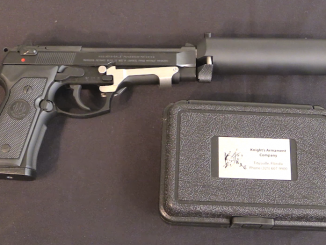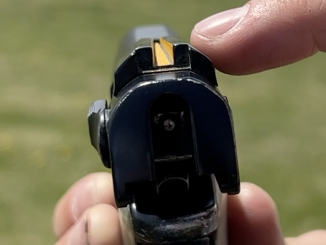From Richard on Patreon:
“Why didn’t the M3 and M3A1 (grease gun) have a double stack/double feed mag and use the Thompson mag? It would have certainly simplified logistics.”
The answer to the first part is that the M3 used a single-feed magazine because it was largely copied from the Sten. A new magazine was necessary, and the Sten design looked like a good enough design that was inexpensive and worked well in a stamped SMG.
The answer to the second part is that the Thompson magazine is retained in a gun in a way that is not compatible with a simple stamped design like the Sten or M3. The Thompson has a large T-shaped lug on the back of the magazine that slides up into a matching track behind the magazine well. The Thompson has a big milled block of a receiver that can accommodate this track easily. Several other US SMGs did actually copy or use the Thompson magazine (the M2 and the UD-42, specifically), but these were also designs with blocky solid receivers. The stamped design of the M3 (copied from the Sten) had no such block of material where that sort of magazine retention could be placed.
Related Videos:
M2 – https://youtu.be/08_mAlLrbTI
M2 at the Range – https://youtu.be/Nynxl9bgy9Q
UD42 – https://youtu.be/fnGoAWhVUxc
UD42 at the Range – https://youtu.be/rk7uHfTz6K0
Thompson 1921 – https://youtu.be/QN1uUfMCQ0Y
Thompsons at the Range – https://youtu.be/smhTeK8T3rg
Thompson T2 Prototype – https://youtu.be/1o9q5Xh69AM




The question is valid – having two different .45 SMG magazines did indeed cause some logistical issues in the field during WWII. I have read (don’t recall the title of the book right now) that a guerrilla unit in the Philippines received an airdrop of supplies that included grease gun mags when they were armed with Thompsons.
Army Ordnance: Recognizes that a .45 SMG can’t use many of the same parts as the 9mm STEN anyway, and changes the design in all sorts of superficial ways.
Also Army Ordnance: Feels obliged to copy one of its worst features (also complicating logistics) verbatim.
It would have been easier to notch the Thompson mag (like Colt did with the Uzi) than scratch-design a .45 STEN mag – or simply forgo the T-slot and treat the rail like the back face of a deeper box mag.
I think that you missed a key factor. The M3 uses a single feed magazine which allows a MUCH simpler barrel and barrel nut. They are both machined on turning operations and then assembled together which is then screwed into the receiver. There is no attempt to index the barrel to the receiver. With a dual feed magazine like the Thompson they would have needed to machine in a wide feed ramp in the barrel nut to accept cartridges from either side of the magazine rather than from a central position that a single feed offers. This in turn would require a method to assure that the feed ramp was correctly positioned on every gun every time the barrel assembly was installed.
I bet that they looked at both alternatives and just decided that they would deal with the logistical headaches of two magazines.
The original ramp on the dual-feed Uzi is a stamping simpler than a spoon.
Other dual-feed SMGs turn a conical taper into the barrel and/or trunnion behind the chamber mouth. Even though the top portion doesn’t accomplish anything, it certainly doesn’t hurt either.
Like a pin on the barrel to orient it into the receiver. Like the STEn Mk V.
It is my understanding that the M3 was designed to be caliber convertible from 45 ACP to 9mm Luger. The conversion kit included an adapter to use a Sten magazine. I’ve been under the impression that some M3’s were made in 9mm and were designed to use standard Sten magazines. During trials the single feed caused issues, but the design was not modified.
Why the M-3 didn’t use a tube design like the STEn always confused me. When my 7/2 goes through, I’m going find a M-3 parts kit and build it with a new post sample tube. Re-machine the bolt for double feed. And a new design mag well the use Thompson mags. I want to prove this would have been the better way to go.
I agree. All the crazy engineering and die milling that had to go into making those elaborately-shaped mating halves, when a round tube on a rectangle tube would have worked just fine.
If you ever do that project, please find a way to post and link it so we can follow your progress!
What type of magazines was used in .30 version of M3 mentioned here https://www.forgottenweapons.com/book-review-the-us-m3-m3a1-submachine-gun-by-michael-heidler/
?
Receiver construction methods were determined by existing tooling. British factories had fewer tools, so favored labor-intensive production methods. Sten production was farmed out to tiny “shadow factories” that were automobile repair shops with a few powered machine tools: drill press, band saw, lathe, milling machine, etc. for resurfacing brake drums, valves, etc. Most Sten parts can be made with a hacksaw and drill. One shadow factory may only have made a single part of the trigger mechanism, but it produced hundreds per month.
During the 1930s, British industry could not afford to invest in heavy, expensive tooling, but had plenty of under-employed, semi-skilled factory laborers. The British gov’t was deathly afraid that under-employed workers would turn communist and riot or strike. So British manufacturing methods may have been more labor intensive, but busy workers were less likely to riot or go on strike.
The cheapest version ($8) of the Sten Mark 3 had a receiver made from a flat sheet of steel with cut-outs for the ejection port, etc. then bent into a tube and welded along the top rail. Mark 3 Sten was primarily made in Canada by the Canadian automotive industry.
OTOH M3 Grease Gun was designed around North American automobile production tooling that included huge presses designed to stamp out sheet metal car body panels at the rate of one per second. The same tooling could stamp out one M3 receiver half per second. These large, heavy and expensive presses compensated for chronic shortages of skilled labor in North America. Then automated spot-welding machines joined the two halves. Each receiver half incorporated parts of the magazine well, pistol grip, trigger mechanism, etc. so that an automobile factory may have been tooling-intensive, but it could stamp out hundreds of M3 parts per hour at a comparatively low labor cost.
I say the M3 should not even exist. After the M1 carbine (with a better folding stock) entered service it should have entirely replaced the submachine gun. Much lighter weapon. Much lighter ammo. Much higher muzzle energy.
All very true. But even with about 6 million carbines made during the war (as opposed to about 1 million Garands) there were never enough to go around.
The main motivator though was the Tank Board. They wanted a replacement for the TSMG as personal weapons for the tank crews, and they specified that it had to be .45 ACP caliber, because the internal stowage for small arms ammunition in the M3 and M5 Stuart and M4 Sherman tanks was designed around the standard .45 ACP ammunition boxes.
In fact, the TSMG hung on as part of the tank crews’ equipment well into the Vietnam era. The M3A1 was still standard tank crew issue as late as the first Gulf War in 1991.
In-between, tankers scrounged what they preferred anywhere they could. My uncle who commanded a tank troop in 2AD from Normandy to Thuringia managed to luck into a folding-stock M1A1 just before Operation COBRA. Two of his crewmen had “liberated” MP40s.
Another of my uncles stuck to what he’d kept in the cab of his truck as a civilian long haul trucker; a sawed-off double-barreled 10-gauge.
His boss, Gen. Patton, thought that was sensible.
cheers
eon
I remember when Eon first laid out the case Max just made as one of the most thought-provoking arguments I’d ever read. I agree that the Carbine made SMGs obsolete overall, but it’s also more expensive and longer (an issue in tanks, as Eon pointed out here). I do think it’s quite amenable to further simplification, and could have probably been produced in a “tanker” shorty configuration as well.
The 1960s-70s Iver Johnson “Enforcer” pistol version of the Carbine
https://images.guns.com/wordpress/2012/12/Enforcer13.jpg
With the M1A1 folding stock, and the fire selector of the M2, would have made a highly interesting PDW to replace both the “Grease Gun” and probably the M1911 pistol as well.
While there was some loss of MV and energy in the shorter barrel, it still delivered 1,650 F/S and 670 FPE at the muzzle, down to 540 at 300 yards. So at 300 it was still hitting like a .357 Magnum at the muzzle.
Chambered for 5.7 x 33mm Johnson Spitfire (aka “father of 5.7 x 28 FN”), it might have caused us to re-evaluate the whole “PDW/stopping power” issue fifty years ahead of historical.
cheers
eon
Yes, that Enforcer shows what’s possible, but the downrange numbers looked optimistic for the blunt little 110. I plugged them into Hornady’s calculator and got 918fps / 206ftlb at 300. Still quite respectable, particularly considering who typically carries PDWs.
Ironically the Spitfire (despite being old and low-pressure) outperforms its “son” from essentially identical dimensions.
“(…)M1 carbine(…)”
This weapon does not provide full-auto capability. There existed version with selective capability named M2 Carbine but its’ production started in 1945 that is later than M3 was available.
“(…)with a better folding stock(…)”
This was done and adopted as M1A3 Carbine see 1st photo from top
https://www.reddit.com/r/MilitaryPorn/comments/sut7if/the_m1a3_carbine_it_was_officially_adopted_and/
The M1 Carbine started as a select fire weapon, but the select fire requirement was dropped during the testing phase. Then troops using M1 Carbines as front line weapons asked for full auto capability. Many M2 carbines are M1 carbines converted to select fire. The conversion was easy, since the original design included select fire.
full auto is highly overrated, if you must carry yr ammunition you don`t want to waste it, 500 rpm from maybe a couple of hundred rounds doesn`t give you much engagement time and remember while changing or loading magazines you are effectively unarmed, once engaged you are not in total control of the situation so aimed semi-auto fire, rapid if necessary, is the way to go, in my experience. Your mileage may differ.
The Thompson had the slightly complicated mag design it did to allow for the drum magazine design it used.
Right – and without the requirement to use drums (which was deleted from later Thompsons anyway), one could forgo the complexity.
Another factor was the Thompson was designed with 50 and 100 round magazines in mind as well as the 20 rd mags